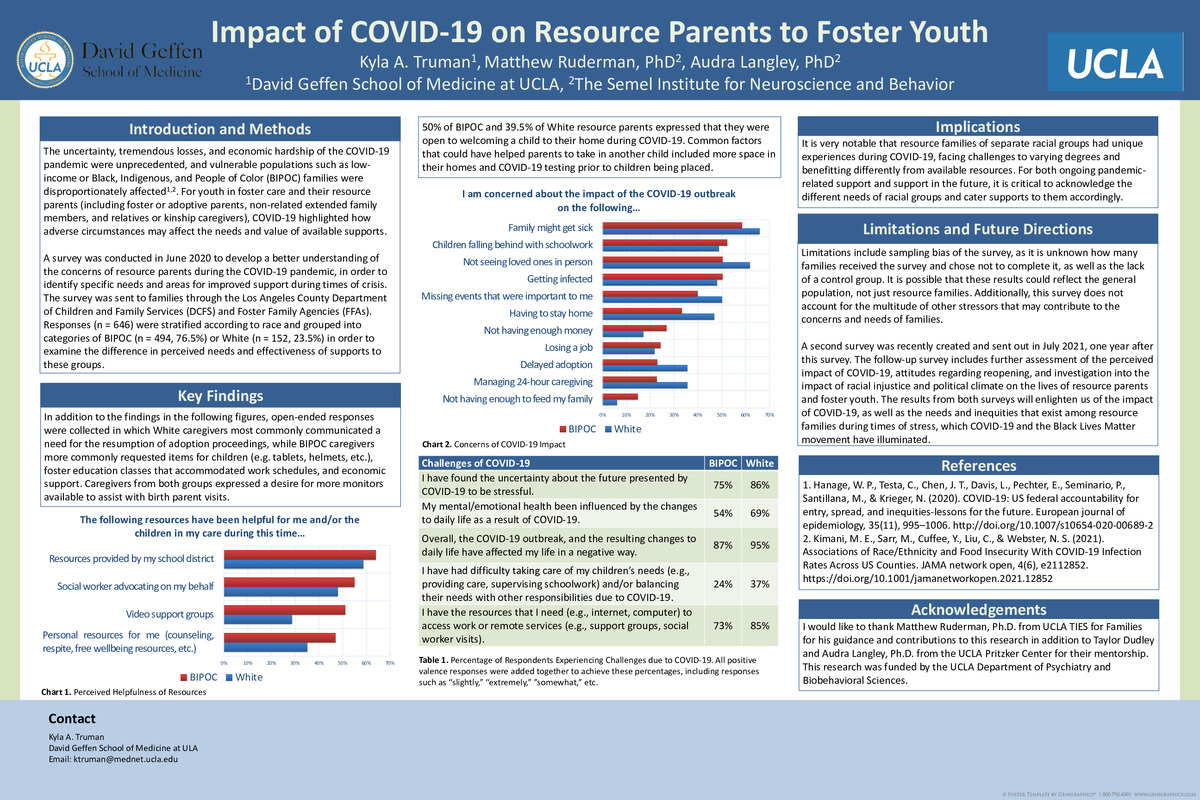-
Author
Kyla Truman -
PI
Matthew Ruderman, PhD; Audra Langley, PhD
-
Co-Author
Matthew Ruderman, PhD; Audra Langley, PhD
-
Title
Impact of COVID-19 on Resource Parents to Foster Youth
-
Program
CTSI TL1 Summer Program
-
Other Program (if not listed above)
-
Abstract
Introduction: The uncertainty, tremendous losses, and economic hardship of the COVID-19 pandemic were unprecedented, and vulnerable populations such as low-income or Black, Indigenous, and People of Color (BIPOC) families were disproportionately affected1,2. For youth in foster care and their resource parents (including foster or adoptive parents, non-related extended family members, and relatives or kinship caregivers), COVID-19 highlighted how adverse circumstances may affect the needs and value of available supports.
Methods: A survey was conducted in June 2020 to better develop an understanding of the concerns of resource parents during the COVID-19 pandemic, in order to identify specific needs and areas for improved support during times of crisis. The survey was sent to families through the Los Angeles County Department of Children and Family Services (DCFS) and Foster Family Agencies (FFAs). Responses (n = 646) were stratified according to race and grouped into categories of BIPOC (n = 494, 76.5%) or White (n = 152, 23.5%) in order to examine the difference in perceived needs and effectiveness of supports to these groups.
Results: In addition to the findings in the following figures, open-ended responses were collected in which white caregivers most commonly communicated a need for the resumption of adoption proceedings, while BIPOC caregivers more commonly requested items for children (e.g. tablets, helmets, etc.), foster education classes that accommodated work schedules, and economic support. Caregivers from both groups expressed a desire for more monitors available to assist with birth parent visits. 50% of BIPOC and 39.5% of white resource parents expressed that they were open to welcoming a child to their home during COVID-19. Common factors that could have helped parents to take in another child included more space in their homes and COVID-19 testing prior to children being placed.
Discussion: It is very notable that resource families of separate racial groups had unique experiences during COVID-19, facing challenges to varying degrees and benefitting differently from available resources. For both ongoing pandemic-related support and support in the future, it is critical to acknowledge the different needs of racial groups and cater supports to them accordingly. Limitations include sampling bias of the survey, as it is unknown how many families received the survey and chose not to complete it, as well as the lack of a control group. It is possible that these results could reflect the general population, not just resource families. Additionally, this survey does not account for the multitude of other stressors that may contribute to the concerns and needs of families. A second survey was recently created and sent out in July 2021, one year after this survey. The follow-up survey includes further assessment of the perceived impact of COVID-19, attitudes regarding reopening, and investigation into the impact of racial injustice and political climate on the lives of resource parents and foster youth. The results from both surveys will enlighten us of the impact of COVID-19, as well as the needs and inequities that exist among resource families during times of stress, which COVID-19 and the Black Lives Matter movement have illuminated.
References:
1. Hanage, W. P., Testa, C., Chen, J. T., Davis, L., Pechter, E., Seminario, P., Santillana, M., & Krieger, N. (2020). COVID-19: US federal accountability for entry, spread, and inequities-lessons for the future. European journal of epidemiology, 35(11), 995–1006. http://doi.org/10.1007/s10654-020-00689-2
2. Kimani, M. E., Sarr, M., Cuffee, Y., Liu, C., & Webster, N. S. (2021). Associations of Race/Ethnicity and Food Insecurity With COVID-19 Infection Rates Across US Counties. JAMA network open, 4(6), e2112852. https://doi.org/10.1001/jamanetworkopen.2021.12852
-
PDF
-
Zoom
https://uclahs.zoom.us/j/99359811357?pwd=ZmRJSVBPVVp6TDkrcmF4T3UzL3N4Zz09

